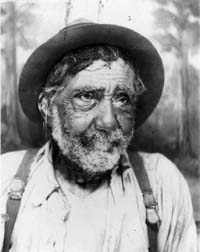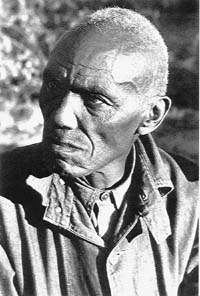 Green Hill plantation as seen from the fields (Photograph by Jack E. Boucher, 1960)
Green Hill plantation as seen from the fields (Photograph by Jack E. Boucher, 1960)
![[Next]](images/next.gif)
 Green Hill plantation as seen from the fields (Photograph by Jack E. Boucher, 1960)
Green Hill plantation as seen from the fields (Photograph by Jack E. Boucher, 1960)
|

|
The Big House was a two-story house; white like most houses during that time. On the north side of the Big House sat a great big barn, where all the stock and stuff that was raised was kept. Off to the southwest of the barn, west of the Big House, set about five or six log houses. |
| William Henry Towns, former slave from Colbert County, Alabama (Photograph possibly Levis D. Shelby, Jr. ca. 1938) |
The mansions at the larger plantation estates instantly conveyed an image of greatness, authority, and success with their impressive facades, gardens, and formal white columns. But great houses were only a small part of any plantation. The most important elements of any planter's domain actually lay beyond his residence. Here, back of the Big House, is where slaves did the work that produced their owner's wealth. Here a captive people struggled to live as decently as they could. Here African Americans etched their mark on the southern landscape and created cultural traditions that endure to this day.
 Milford, Sumter County, South Carolina
(Photograph by Jack E. Boucher, 1960)
Milford, Sumter County, South Carolina
(Photograph by Jack E. Boucher, 1960)
Built in 1850 for Governor John C. Manning, this classically styled mansion was constructed with granite imported from far-off Rhode Island. Because the house contained many features then regarded as frivolous luxuries, such as running water on the second floor, the house was often referred to as "Manning's Folly."
In 1850 this vast sugar-producing estate on the banks of the Mississippi River was run with the labor of 165 slaves whose houses can been seen to the right of the mansion house and off in the distance near the fields.
The federal census data for 1860 indicates both the number of slaves and the location of the major plantation zones in the South. The principal areas include: eastern Virginia, the southeastern coast of the United States, a band of counties running through the middle of the deep South, the Florida panhandle, the lower Mississippi Valley, and eastern Texas.
 Shad Hall, former slave on Sapelo Island,
Georgia
(Photograph by Muriel and Malcolm Bell, ca. 1939)
Shad Hall, former slave on Sapelo Island,
Georgia
(Photograph by Muriel and Malcolm Bell, ca. 1939)
Next section of The Cultural Landscapes of the Plantation Exhibition
Table of contents for The Cultural Landscapes of the Plantation Exhibition